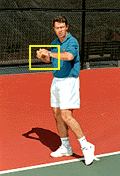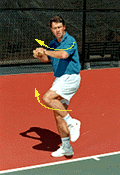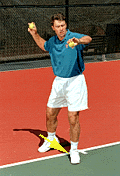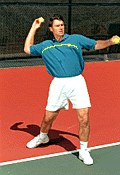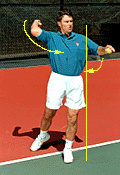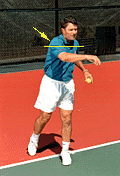|
TennisOne Lessons
The Dynamics of Throwing a Ball - Jim McLennan, Senior Editor, TennisONE (Former President, USPTA, Northern California) The dynamics of throwing a ball provide an excellent model for training how to hit both the serve and the forehand. Shift of weight, use of both arms, rhythmically connecting the left and right sides of the body-these are issues both on the forehand, the serve, or the throw. This lesson was developed from a close application of the "Mechanics of Pitching Checklist," written by Dr. Joe Bramhall, University of Texas. Bramhall developed this checklist by examining the pitching mechanics of 40 professional baseball players, and then generalizing about the features that they all had in common. I have just applied his checklist to tennis.
The uncoiling left leg will help generate angular momentum (turning energy) before I throw. In the third photo my hands have split and I have shifted my weight to the front foot. If you practice as you read this, it should feel like your left hand and left foot move at the same time, rhythmically. Can this really be so important? The answer is an emphatic, yes! Closely watch someone who can't throw very well. You will always see a hanging left arm (that isn't being used) and very little weight shift. Then compare this with someone you know who does throw well, and most, if not all of these key movements below will be dramatically present. In the next sequence, we'll see how mastering these movements this will help your serve and forehand. Before we shift to the technical analysis and photos below, let me share a personal testimonial of Dr. Bramhall's "Mechanics of Pitching Checklist" - and pardon the "proud papa" syndrome. I first read the checklist in 1992, and thinking Bramhall's theory was sound, I put the theory to the test-on my four year old son. We practiced with the turn with his hands starting together. He would hold two tennis balls, and he had to have the balls touch as he turned. Once he was comfortable with this, he then practiced holding up his left knee as the balls touched. From there he threw, and threw and threw. Not for power or length, but just as his starting style. Now at age eight, he can throw further and faster than almost any of the kids in his age group. I give credit top Bramhall's checklist, with its emphasis on bringing the hands together as the knee goes up. This is the key to starting a powerful throwing motion, and will be equally vital to improving your forehand or serve.
In the previous sequence of photos, I started with my hands together, sideways to the target, weight on the back foot. Then I split my hands, shifted forward and began to unwind. Now in the first photo below I have continued to unwind. Notice how my chest bows. You can see the identical position prior to Sampras' swing into the serve. The left arm has cleared, the right elbow remains flexed, and the ball is trailing. This is quite similar to the forehand where the racquet is the last thing to come through in the swing. Before we shift to the technical analysis and photos below, let me share a personal testimonial of Dr. Bramhall's "Mechanics of Pitching Checklist" - and pardon the "proud papa" syndrome. I first read the checklist in 1992, and thinking Bramhall's theory was sound, I put the theory to the test-on my four year old son. We practiced with the turn with his hands starting together. He would hold two tennis balls, and he had to have the balls touch as he turned. Once he was comfortable with this, he then practiced holding up his left knee as the balls touched. From there he threw, and threw and threw. Not for power or length, but just as his starting style. Now at age eight, he can throw further and faster than almost any of the kids in his age group. I give credit top Bramhall's checklist, with its emphasis on bringing the hands together as the knee goes up. This is the key to starting a powerful throwing motion, and will be equally vital to improving your forehand or serve.
In the previous sequence of photos, I started with my hands together, sideways to the target, weight on the back foot. Then I split my hands, shifted forward and began to unwind. Now in the first photo below I have continued to unwind. Notice how my chest bows. You can see the identical position prior to Sampras' swing into the serve. The left arm has cleared, the right elbow remains flexed, and the ball is trailing. This is quite similar to the forehand where the racquet is the last thing to come through in the swing. |

